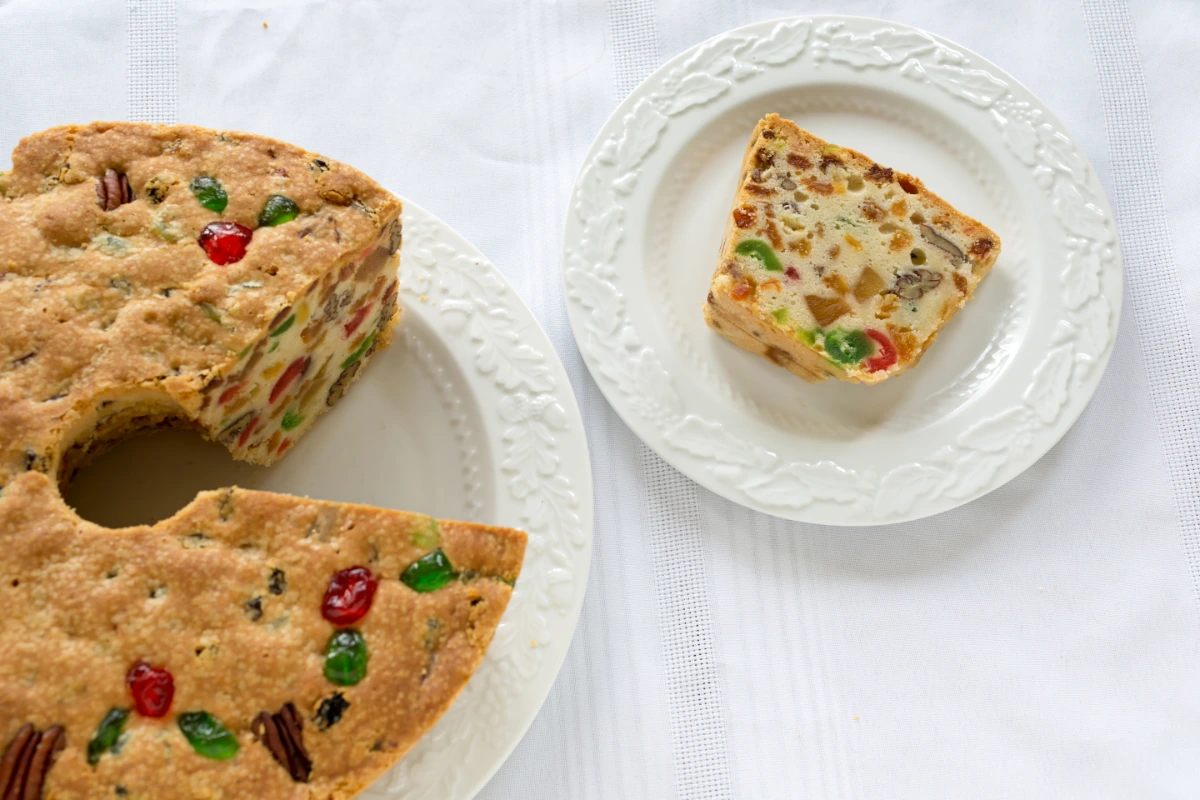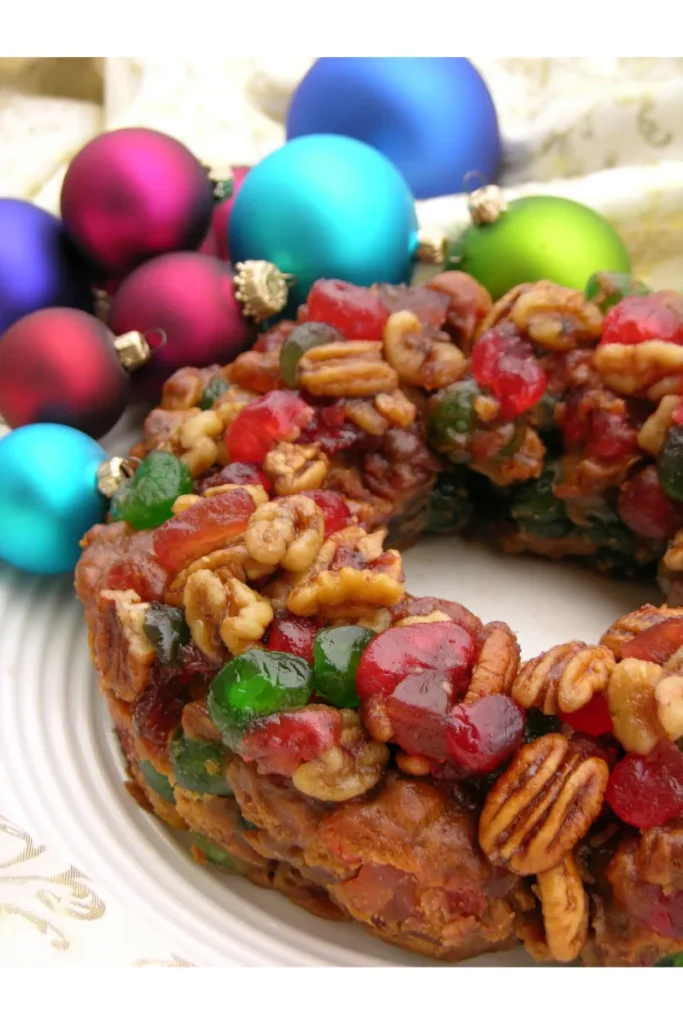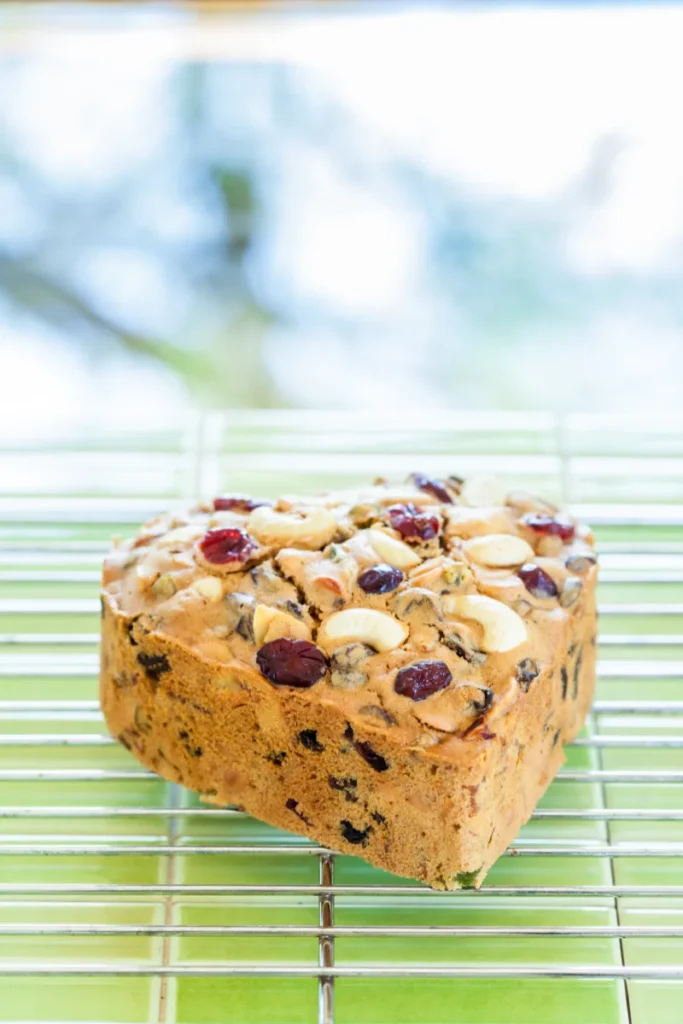Ah, fruitcake. The mere mention of this word conjures up a range of emotions, from nostalgic delight to outright disgust. This dense, often misunderstood dessert has been a part of culinary traditions for centuries, yet it remains one of the most polarizing treats around. So, what exactly is fruitcake, and why does it evoke such strong reactions?
Demystifying Fruitcake
In its simplest form, fruitcake packs dried fruits, nuts, and spices into a cake. Its origins trace back to ancient Rome, where people enjoyed a mixture of barley, pomegranate seeds, nuts, and raisins as a celebratory food. Over time, fruitcakes evolved, with various cultures adopting different forms and flavors.
Today, fruitcake exists in countless iterations around the globe. From the boozy, fruit-laden British Christmas cake to the lighter, citrusy Italian panettone, each region boasts its unique take on this classic dessert.
Despite its rich history and diverse interpretations, fruitcake has become the butt of many jokes and a symbol of holiday excess. But why is this festive dessert so often ridiculed?
One reason might be its dense texture, which can be off-putting for some. Additionally, commercially produced fruitcakes often contain artificial flavors and preservatives, leading to a less-than-desirable taste and texture.
However, it’s important to remember that homemade fruitcake, made with love and quality ingredients, can be a truly delicious and satisfying treat. Many people cherish the complex flavors and rich history of fruitcake, considering it an essential part of their holiday traditions.
So, before you dismiss fruitcake as a mere doorstop or gag gift, consider giving it another chance. You might just be surprised by the delightful flavors and textures that await your discovery.
The Anatomy of a Fruitcake: Ingredients and Preparation
Now that we’ve explored the history and cultural significance of fruitcake, let’s delve into the heart of this dessert: its ingredients and preparation. What exactly goes into a fruitcake, and how do these components come together to create its unique flavor and texture?
Essential Ingredients:
- Dried Fruits: The stars of the show, dried fruits like raisins, currants, cranberries, cherries, and apricots provide sweetness, tartness, and bursts of concentrated flavor. Soaking the fruits in rum, brandy, or fruit juice plumps them up and enhances their taste.
- Nuts: From crunchy almonds and walnuts to buttery pecans and macadamia nuts, nuts add texture, richness, and depth of flavor to fruitcakes. Toasting the nuts beforehand intensifies their flavor and aroma.
- Spices: Warm spices like cinnamon, nutmeg, cloves, and ginger are essential for creating the characteristic fruitcake flavor profile. Some recipes also include cardamom, allspice, or even a touch of black pepper for added complexity.
- Flour and Sugar: While dried fruits and nuts take center stage, flour and sugar provide the structure and base for the cake. Different types of flour, such as all-purpose, cake flour, or even almond flour, can be used, depending on the desired texture. Sugar, whether white, brown, or a combination, adds sweetness and contributes to the cake’s moistness.
- Optional Ingredients: Many fruitcake recipes include additional ingredients like candied citrus peel, chopped dates, figs, or even chocolate chips for extra flavor and texture. Some recipes also call for eggs, butter, and leavening agents like baking powder or baking soda.
Baking the Perfect Fruitcake:
Making a delicious fruitcake requires careful attention to detail and a bit of patience. Here’s a general overview of the baking process:
- Preparing the Fruits and Nuts: Soaking the dried fruits in your chosen liquid plumps them up and infuses them with flavor. Chopping the nuts and toasting them enhances their texture and taste.
- Mixing the Batter: Combining the dry ingredients, creaming butter, and sugar (if using), and incorporating the fruits, nuts, and spices are key steps in creating a well-balanced batter.
- Baking and Cooling: Fruitcakes are typically baked at a low temperature for a long time to ensure even cooking and prevent drying out. Once baked, the cake needs to cool completely before any additional steps.
- Feeding (Optional): Some fruitcake enthusiasts swear by “feeding” the cake with additional liquor or syrup periodically to keep it moist and enhance its flavor. This step is optional but can contribute to a richer and more complex taste.
- Storage and Aging: Fruitcakes are known for their longevity and can be stored for weeks or even months in an airtight container. Many believe that fruitcake tastes even better with age, as the flavors have time to meld and mature.
Tips and Techniques:
- To prevent the fruits from sinking to the bottom of the cake, toss them in a little flour before adding them to the batter.
- Lining your baking pan with parchment paper ensures easy removal and prevents sticking.
- Use a kitchen thermometer to check the internal temperature of the cake for doneness.
- Avoid overbaking, as this can lead to a dry and crumbly fruitcake.
With the right ingredients and techniques, you can create a delicious and memorable fruitcake that will be enjoyed by all.
A Global Tour of Fruitcake: Regional Variations and Traditions
Fruitcake may be a universal symbol of holiday cheer, but its journey through history has resulted in a diverse array of regional variations and traditions. Let’s embark on a global tour to discover how different cultures have embraced and adapted this classic dessert.
British Fruitcake:
Perhaps the most iconic fruitcake iteration, the British Christmas cake is a dense, rich cake packed with dried fruits, nuts, and spices. Traditionally soaked in brandy or rum, it’s often covered with marzipan and royal icing, creating a festive centerpiece for Christmas celebrations.
American Fruitcake:
In the United States, fruitcake takes on a more diverse and sometimes controversial identity. While some American fruitcakes resemble their British counterparts, others are lighter and feature a wider variety of fruits and nuts. Some regions even boast unique local specialties, like the bourbon-soaked Kentucky fruitcake.
European Fruitcakes:
Europe offers a delightful spectrum of fruitcake variations. Germany’s Stollen is a bread-like cake filled with dried fruits, nuts, and marzipan, often dusted with powdered sugar. Italy’s Panettone is a tall, dome-shaped cake studded with candied citrus peel and raisins, enjoyed during the Christmas season.
Caribbean Black Cake:
A beloved tradition in the Caribbean, black cake is a dense, dark fruitcake made with molasses, rum-soaked fruits, and spices. This rich and flavorful cake is often served during weddings, Christmas, and other special occasions.
Fruitcake Traditions Around the World:
From Australia’s rum-soaked Christmas pudding to India’s rich and fragrant plum cake, fruitcake traditions extend far and wide. Each culture adds its unique twist, incorporating local ingredients and customs into this timeless dessert.
Fruitcake’s global journey demonstrates its adaptability and enduring appeal. Whether enjoyed as a festive centerpiece or a year-round treat, this dessert continues to hold a special place in hearts and on tables around the world.
Beyond the Holidays: Enjoying Fruitcake Year-Round
While fruitcake is often associated with the holiday season, its rich flavors and versatility make it a treat that can be enjoyed throughout the year. Let’s explore some creative ways to incorporate fruitcake into your culinary repertoire beyond the festive period.
Serving Suggestions and Pairings:
- Classic Slice: A simple slice of fruitcake is a satisfying dessert on its own. Pair it with a cup of tea, coffee, or a glass of dessert wine for an afternoon pick-me-up or a light after-dinner treat.
- Toasted and Buttered: Toasting a slice of fruitcake enhances its flavors and adds a delightful crunch. Spread a thin layer of butter for an extra touch of indulgence.
- Fruitcake with Cheese: The sweetness of fruitcake pairs beautifully with the savory notes of cheese. Try it with a sharp cheddar, creamy brie, or tangy blue cheese for a delightful contrast of flavors.
- Fruitcake Crumble: Transform leftover fruitcake into a delicious crumble by topping it with a streusel made from flour, sugar, and butter. Bake until golden brown and bubbly for a comforting and flavorful dessert.
- Fruitcake Ice Cream: Incorporate chopped fruitcake into your favorite ice cream recipe for a festive and flavorful twist. The combination of creamy ice cream and chewy fruitcake pieces is simply irresistible.
Modern Twists on Classic Recipes:
- Fruitcake Cookies: Take the flavors of fruitcake and transform them into bite-sized cookies. These treats are perfect for sharing and offer a convenient way to enjoy the taste of fruitcake any time.
- Fruitcake Pancakes or Waffles: Add chopped fruitcake to your pancake or waffle batter for a delicious and festive breakfast or brunch option. Top with whipped cream, maple syrup, or fresh fruit for an extra burst of flavor.
- Fruitcake French Toast: Elevate your French toast by using thick slices of fruitcake instead of bread. The result is a decadent and flavorful breakfast treat that is sure to impress.
Fruitcake as a Gift:
Fruitcake makes a thoughtful and personalized gift for any occasion. Wrap it beautifully or present it in a decorative tin for a touch of elegance. You can even personalize it by adding a handwritten note or decorating it with edible embellishments.
Don’t relegate fruitcakes to the back of the pantry after the holidays. With a little creativity, you can enjoy its unique flavors and textures year-round. So, embrace the versatility of fruitcake and discover new ways to savor this timeless treat.
FAQs about Fruitcake: Demystifying the Myths and Misconceptions
Fruitcake is a dessert shrouded in mystery and often subject to misconceptions. Let’s address some frequently asked questions to shed light on this intriguing treat and dispel some common myths.
Q: What makes fruitcake so dense and heavy?
A: The high concentration of dried fruits and nuts gives fruitcake its dense texture. These ingredients contain sugars and fibers, which make the cake compact and weighty. Additionally, some fruitcake recipes incorporate a higher proportion of flour to liquid compared to other cakes, adding to its density.
Q: How long does fruitcake last?
A: Fruitcake is renowned for its longevity. When properly stored in an airtight container, it can last for several weeks at room temperature and even longer in the refrigerator or freezer. The high sugar content and low moisture level act as natural preservatives, inhibiting the growth of bacteria and mold.
Q: Can fruitcake be frozen?
A: Yes, fruitcake freezes exceptionally well. Wrap it tightly in plastic wrap and then in aluminum foil to prevent freezer burn. When ready to enjoy, thaw the fruitcake overnight in the refrigerator or at room temperature.
Q: How to “feed” a fruitcake and keep it moist?
A: “Feeding” a fruitcake involves periodically brushing or drizzling it with liquor, syrup, or fruit juice. This process helps to maintain its moisture and enhance its flavor. While not strictly necessary, feeding can contribute to a richer and more flavorful cake.
Q: Are there any healthy alternatives in fruitcake recipes?
A: While fruitcake is traditionally known for its richness, there are ways to make it slightly healthier. Using whole wheat flour, reducing the amount of sugar, and opting for naturally dried fruits without added sugar are some ways to boost the nutritional value of fruitcake. Additionally, incorporating nuts and seeds provides healthy fats and protein.
By understanding the characteristics and qualities of fruitcake, we can appreciate its unique appeal and dispel some of the negative stereotypes associated with this classic dessert.
Conclusion: Fruitcake – A Timeless Tradition Worth Trying
Fruitcake, with its rich history and diverse interpretations, is more than just a holiday dessert. It’s a culinary tradition that has stood the test of time, connecting generations and cultures through its unique flavors and textures.
While its dense texture and intense flavors may not be for everyone, fruitcake deserves appreciation for its complexity and the nostalgic joy it brings to many. From the classic British Christmas cake to the vibrant Caribbean black cake, fruitcake offers a world of flavors to explore and enjoy.
Whether you savor a simple slice with a cup of tea or incorporate it into creative culinary creations, fruitcake is a versatile treat that can be enjoyed year-round. So, this holiday season, and beyond, give fruitcake a chance. You might just discover a new favorite dessert and create lasting memories with this timeless tradition.
More Delicious Recipes:
- Truffle Risotto: Discover the luxurious flavors of our Truffle Risotto, a creamy masterpiece infused with the earthy richness of truffles, guaranteed to elevate your dining experience to new heights.
Truffle Risotto: The Ultimate Guide to Mastering This Italian Classic
- Fried Polenta: Crisp on the outside, soft on the inside, our Fried Polenta offers a delightful contrast of textures and a burst of savory goodness with every bite.



